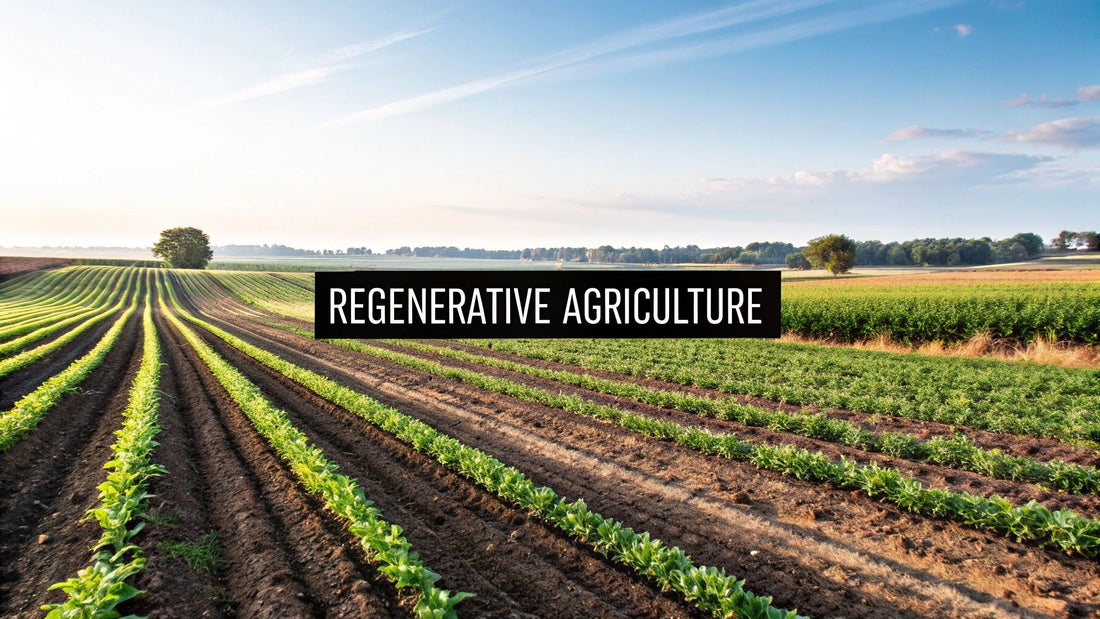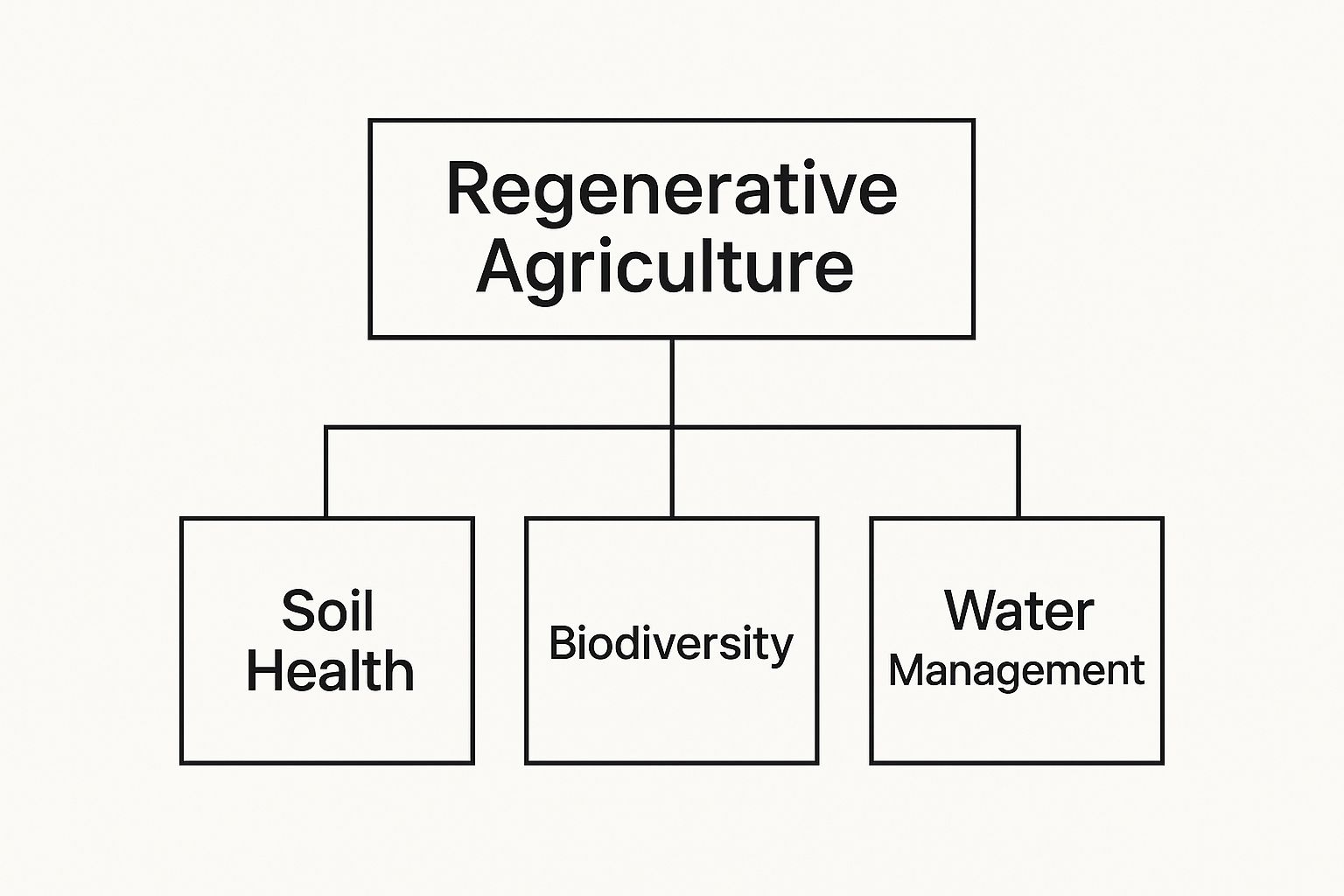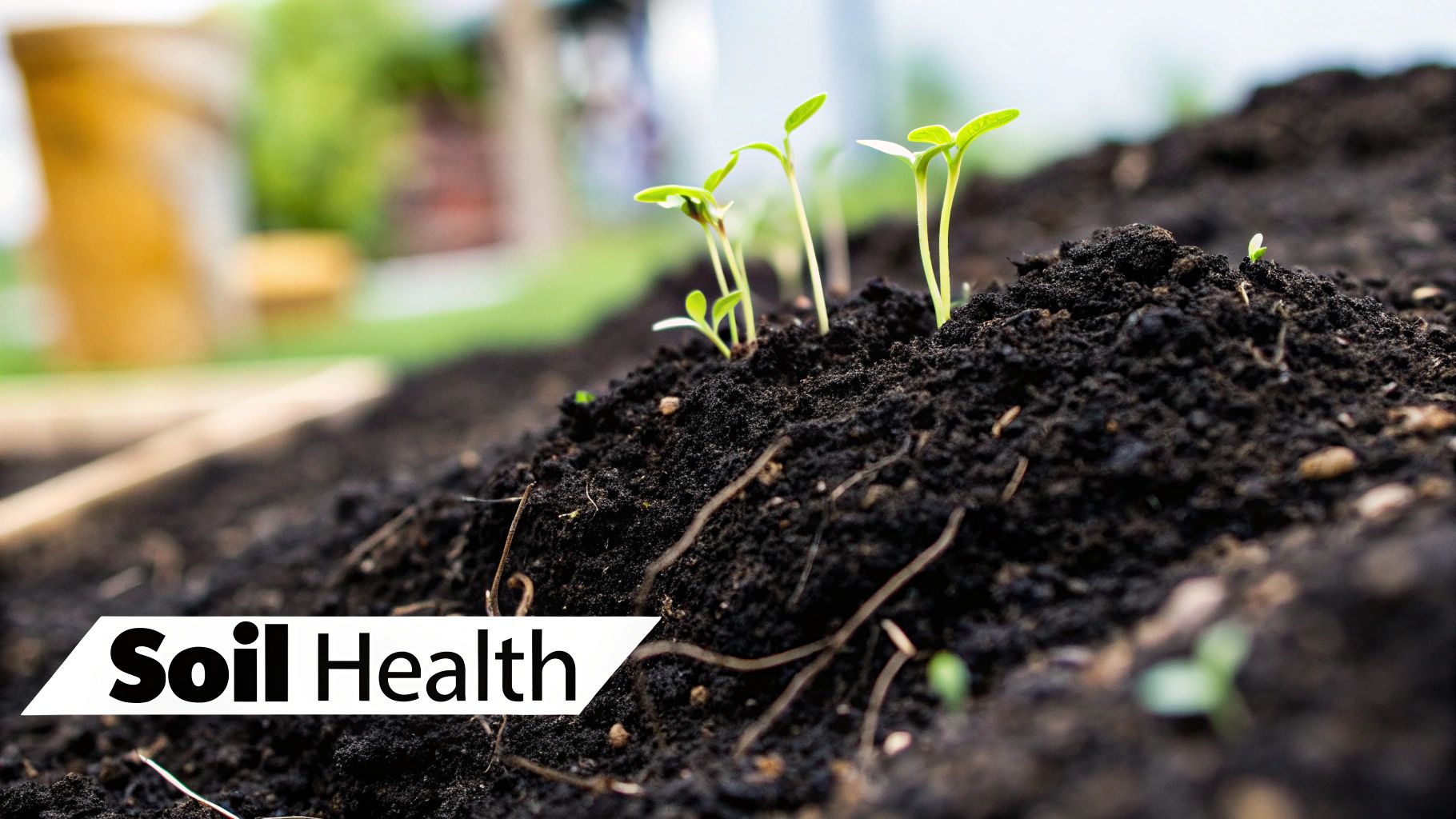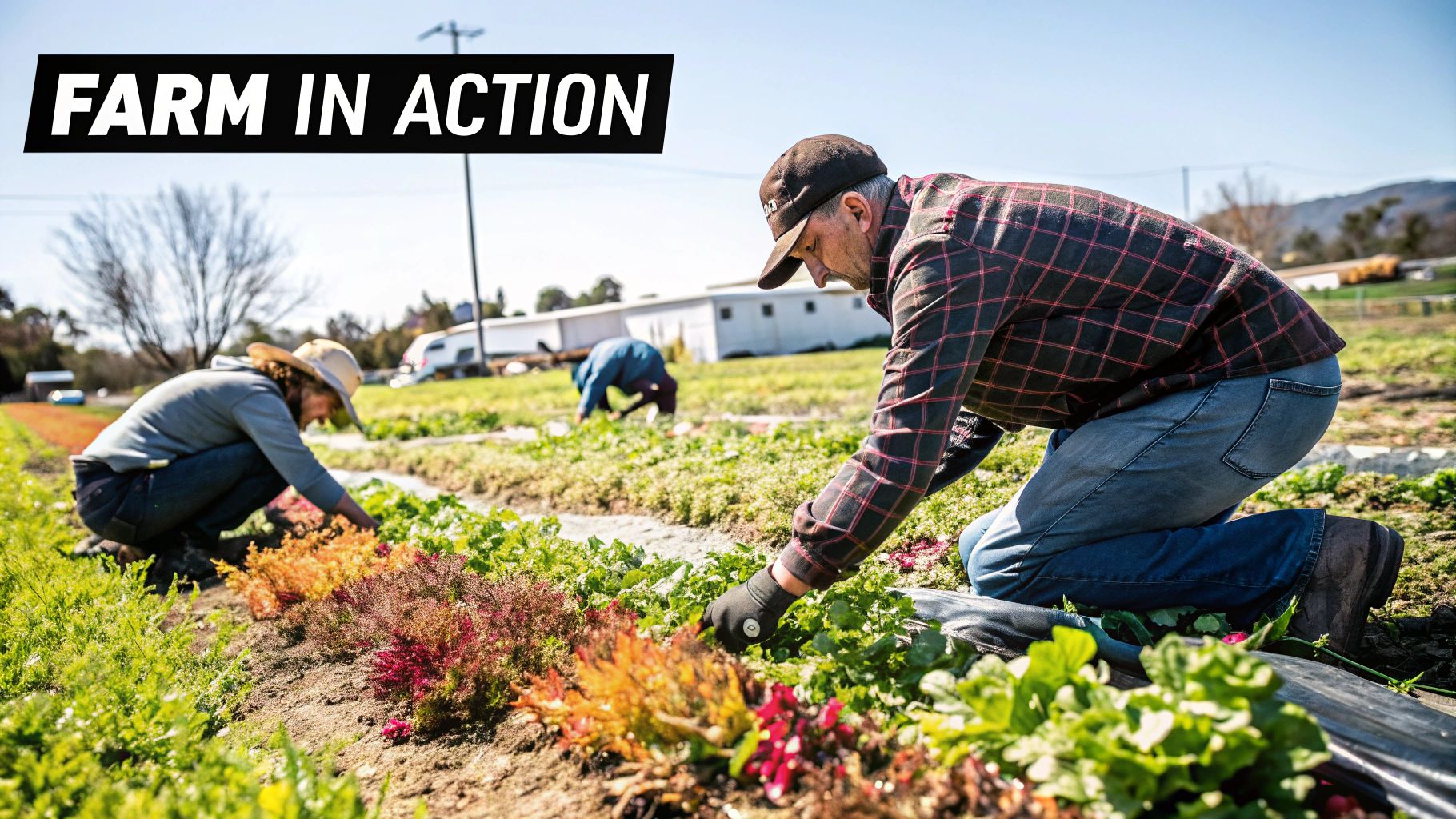
What Is Regenerative Agriculture? A Complete Guide
Share
So, what is regenerative agriculture all about? At its heart, it’s a way of farming that goes beyond simply sustaining the land. Instead, it actively works to heal and improve it.
Imagine your farm's soil as a living, breathing bank account. For a long time, many farming methods have been making constant withdrawals, depleting the account. Regenerative agriculture is all about making deposits—rebuilding soil health, restoring biodiversity, and ensuring that the land is richer for future generations.
A Deeper Look at Regenerative Farming

This approach treats the farm not as a factory, but as a whole, interconnected system. It’s a true partnership with the natural world. Instead of forcing a rigid, human-designed system onto the land, regenerative farmers observe, learn from, and enhance the processes that nature is already doing.
The goal is to let nature lead. The management decisions are all geared toward supporting and restoring the land's own vitality.
By focusing on outcomes like healthier soil, better water cycles, and thriving biodiversity, this approach builds farms that aren't just more sustainable. They become more resilient to climate shocks like droughts and floods.
The Core Philosophical Shift
The biggest difference boils down to mindset. Conventional agriculture often sees problems like pests or weeds as enemies to be wiped out, usually with chemical pesticides and herbicides.
Regenerative agriculture, on the other hand, sees those same issues as symptoms of an imbalanced system. The real solution isn't to kill the symptom; it's to fix the root cause of the imbalance. This means prioritizing the long-term health of the entire farm ecosystem over maximizing short-term yields.
With one-third of the world's soils already degraded, this shift is critical. Regenerative practices work to actively reverse this damage, creating a solid foundation for healthier food and a healthier planet.
Regenerative vs Conventional Farming At a Glance
The table below breaks down the fundamental philosophical and practical differences between conventional and regenerative agriculture systems. It's a useful way to see how the two approaches tackle farming from completely different starting points.
| Core Aspect | Conventional Agriculture | Regenerative Agriculture |
|---|---|---|
| Primary Goal | Maximize yield and efficiency | Improve ecosystem health and resilience |
| Soil Management | Tillage, synthetic fertilizers | No-till/low-till, cover crops, compost |
| Biodiversity | Monoculture (single crops) | Polyculture (diverse crops and plants) |
| Pest Control | Chemical pesticides/herbicides | Natural predators, crop rotation |
| System View | Mechanistic and linear | Holistic and cyclical |
Ultimately, one approach extracts value from the soil, while the other builds value back into it, creating a cycle of regeneration that benefits the land, the farmer, and the consumer.
The Five Core Principles of Regenerative Farming
So, what exactly is regenerative agriculture in practice? To really get a feel for it, you have to look at the five core principles that form its foundation. These aren't just a set of rules; they're more like a framework for thinking differently, for working with nature instead of fighting against it. I like to think of them as the recipe for rebuilding a healthy, thriving farm ecosystem right from the ground up.
Minimize Soil Disturbance
The first principle is all about protecting the incredibly complex world living just beneath our feet. Think about it: aggressive plowing and tilling are like setting off a constant earthquake in the bustling, microscopic city of the soil. All that churning shatters the delicate structures fungi and bacteria have built, destroying their homes and completely disrupting their vital work.
By embracing no-till or low-till farming, farmers can leave that intricate soil structure intact. This simple act allows the web of microbial life to flourish, which in turn dramatically improves how the soil absorbs water and cycles nutrients. It’s a shift from being a disruptive force to becoming a gentle steward of that underground world.
"The unique thing about this ranch is the incorporation of worm tea and chickens to help microorganisms and soil health... Earthworms are nature’s way of putting biology back into the soil, which is exactly what we want." - Jim West, Regenerative Rancher
This infographic shows just how interconnected everything is in regenerative agriculture, with everything stemming from the soil.

As you can see, a central focus on soil health creates a ripple effect, leading to greater biodiversity and much more resilient water cycles.
Keep the Soil Covered
Have you ever walked barefoot on hot asphalt in the middle of summer? That’s essentially what bare soil feels like under the sun. When soil is left exposed, it's an open invitation for wind and rain to carry it away, and it allows the sun to bake the life right out of it. The second principle is about giving the soil a protective shield.
Keeping the ground covered, whether with living plants or a layer of organic mulch, is like giving the earth its own skin. This is often done using cover crops—plants that are grown specifically to protect and feed the soil in the months between cash crop seasons.
This living armor provides a ton of benefits:
- Stops erosion: It literally holds the soil in place during heavy storms or high winds.
- Regulates temperature: It acts as insulation, keeping the soil cooler in the summer and warmer in the winter.
- Saves water: It dramatically reduces how much moisture is lost to evaporation.
- Smothers weeds: It naturally outcompetes weeds, which means farmers can rely less on herbicides.
Maximize Crop Diversity
Nature almost never plants in a monoculture. If you walk through a natural prairie or a forest, you’ll find a huge variety of plants all living together in a complex, balanced system. This third principle simply mimics that natural wisdom by getting away from the industrial model of planting one single crop over thousands of acres.
I often tell people to think of crop diversity like a smart investment portfolio. A portfolio with only one stock is incredibly risky; if that company tanks, you lose everything. It's the same with a farm—a single crop is extremely vulnerable to one specific pest or disease. By planting a diverse range of crops, farmers create an ecosystem that is far more stable and can largely regulate itself.
Maintain Living Roots
The fourth principle is what keeps the whole system humming. The goal is to have a "24/7 underground workforce" continuously feeding the soil biology. In most conventional systems, fields can sit empty and bare for months at a time. In a regenerative system, you want living roots in the ground for as much of the year as humanly possible.
Those roots are constantly leaking out sugars and proteins (called exudates) that feed the beneficial microbes in the soil. It's a trade. In exchange for this food, the microbes make key nutrients available for the plants to use. This constant, give-and-take relationship is the true engine of a healthy soil food web, building that rich, dark, and fertile topsoil year after year.
Integrate Livestock
The final piece of the puzzle brings animals back onto the land, closing the loop and completing the natural cycle. When they're managed the right way, livestock aren't a problem—they're one of the most powerful solutions we have. They become the farm's "mobile recycling and regeneration crew."
Using a practice called holistic planned grazing, animals are moved frequently across pastures in a way that mimics the grazing patterns of wild herds. As they move, they graze the plants, converting that forage into incredibly valuable manure that fertilizes the soil on the spot. Their hoof action also gently aerates the ground, presses seeds into the earth, and stimulates new, vigorous plant growth. This carefully managed process turns livestock from a liability into a primary tool for rebuilding grasslands and soil fertility.
The Payoffs of Regenerative Farming: Good for the Planet, Good for the Wallet
When you start healing the land, something remarkable happens: the farm itself becomes stronger and more profitable. This isn't a trade-off. In regenerative agriculture, environmental health and economic stability are two sides of the same coin, creating a positive feedback loop that benefits everyone.

Let's talk about the big picture first. These farming practices are a powerful tool in the fight against climate change. By focusing on building rich, healthy soil, farms can actively pull carbon dioxide out of the atmosphere and lock it away underground. This process, called carbon sequestration, turns the farm into a natural carbon sponge.
This isn't just a feel-good theory; the impact is very real. Healthy soil also absorbs and holds far more water, which is a game-changer. It dramatically reduces polluted runoff during heavy downpours and makes the entire farm more resilient when drought hits.
Building a More Profitable Farm
From a business perspective, the benefits are just as clear. One of the biggest wins for farmers is breaking free from a dependency on expensive synthetic inputs. When soil is teeming with microbial life, it naturally feeds the crops, slashing or even eliminating the need for costly chemical fertilizers.
This self-sufficiency gives farmers more control over their own destiny. They're no longer scrambling to keep up with volatile fertilizer prices, which leads to more predictable costs and healthier profit margins year after year.
Beyond fertilizer, regenerative agriculture encourages using natural pest control methods. This often means creating habitats that attract beneficial insects—the kind that eat the pests you don't want. It’s another way to cut chemical costs while also boosting the farm's overall biodiversity.
By building a farm's resilience to climate shocks like droughts or floods, regenerative agriculture acts as a powerful form of risk management, protecting both the land and the farmer's livelihood for the long term.
Follow the Money: The Market is Paying Attention
The financial case gets even stronger when you look at market trends. The global push for better soil health is expected to become a USD 5.2 billion market, driving yield increases of up to 20% while helping restore biodiversity.
At the same time, carbon sequestration is creating a USD 2.6 billion opportunity that’s growing at an 18% CAGR. This opens up entirely new revenue streams for farmers, who can now get paid for the carbon they store in their soil through carbon credit markets.
This isn’t just about doing the right thing; it’s a smart business move with very real financial incentives.
A Win-Win for Planet and Pocket
Ultimately, regenerative agriculture shatters the old myth that you have to choose between protecting the environment and making a profit. The core benefits work in harmony, creating a system that is more resilient, productive, and profitable because it's healthier.
Here’s how it all connects:
- Better Soil Fertility: Richer soil means less money spent on fertilizers.
- Improved Water Retention: Soil that holds more water provides a buffer against drought.
- More Biodiversity: A thriving ecosystem offers natural pest and disease control, for free.
- Climate Resilience: Farms are simply better prepared to handle whatever Mother Nature throws at them.
By working with nature instead of against it, farmers can cut costs, lower their risk, and build a more secure future—all while playing a direct role in healing the planet.
Regenerative Agriculture in Action
The theory behind regenerative agriculture is one thing, but seeing it work in the real world is what truly makes the lightbulb go on. The real beauty of this approach is that it’s not a one-size-fits-all prescription. It’s more of a flexible framework that farmers can adapt to their unique corner of the world, whether that's a sprawling grain farm in the Midwest or a high-altitude coffee cooperative.
These stories from the field show that working with nature, instead of against it, is a smart and practical strategy. They prove that switching from conventional farming isn't just about ideals—it's about building a more resilient and profitable business from the ground up.
From Dust to Deep Loam: A Midwestern Grain Farm
Picture a typical large-scale grain farm in the American heartland, a landscape long defined by intensive tilling and single-crop fields. For generations, this farm operated by the book, but the soil was getting tired, and the bills for fertilizers and chemicals kept climbing. The owners knew something had to change.
Their first move was radical: they stopped tilling completely. By adopting no-till methods, they put an immediate end to the erosion that was literally blowing their most valuable asset away. Then, they started planting a diverse mix of cover crops like clover and hairy vetch between their main cash crops of corn and soy. This kept living roots in the ground all year, feeding the vast, invisible world of microbes below.
The results after just a few years were nothing short of incredible:
- The soil's organic matter content more than doubled. Pale, compacted dirt transformed into a dark, rich, and crumbly sponge.
- Water soaked into the ground far more effectively, making the farm much better equipped to handle both sudden downpours and long, dry spells.
- They cut their synthetic nitrogen fertilizer use by over 50%, which meant huge savings.
Coffee, Canopies, and Quality: A High-Altitude Plantation
Now, let’s travel to a coffee plantation high in the mountains of Latin America. The old way was to clear-cut the forest to grow coffee in the harsh, direct sun. Instead, these farmers are embracing agroforestry. They're planting their valuable coffee bushes right under the protective shade of the native tree canopy.
This multi-story system creates a vibrant, self-sustaining ecosystem. The trees give birds a place to live, and those birds eat the pests that would otherwise attack the coffee. The fallen leaves from the trees create a natural, self-renewing mulch that feeds the soil. This not only boosts biodiversity and protects the delicate coffee plants but also produces a noticeably higher-quality bean that fetches a better price on the market.
Rebuilding the Prairie: A Grasslands Rancher
Finally, imagine a rancher on the wide-open grasslands of Texas. Instead of letting her cattle wander and graze one huge pasture down to the nub, she uses holistic planned grazing. With simple, mobile electric fences, she moves the herd through smaller paddocks in quick, intense bursts.
This approach is designed to mimic the natural behavior of the massive bison herds that once shaped the prairies. The short, intense grazing stimulates strong plant regrowth, while the animals' hooves and manure work together to naturally till and fertilize the soil.
Here, the livestock become a tool for regeneration. The rancher isn't just raising cattle; she's actively rebuilding the entire grassland ecosystem, increasing the amount of forage it can produce and its capacity to pull carbon from the atmosphere.
Of course, making these changes isn't always simple, and the initial costs can be a real hurdle. To help more farmers make this leap, federal assistance like USDA grant programs for agricultural potential can be a game-changer. These real-world examples aren't just feel-good stories; they're a practical roadmap to a healthier, more sustainable food system for everyone.
The Global Movement Driving Regenerative Agriculture
Regenerative agriculture has officially broken out of its niche and is blossoming into a full-blown global movement. This isn't some fleeting trend driven by a handful of passionate farmers. What we're seeing is a fundamental economic and cultural shift, with momentum building everywhere from kitchen tables to corporate boardrooms.

A huge part of this shift comes from you—the person buying the food. More than ever, people are asking tough questions about where their food comes from and how it's produced. This demand for transparency is forcing the world’s largest food companies to take a hard look at their supply chains and, in many cases, redesign them from the soil up.
The Power of Consumer Demand
Today's shoppers are incredibly well-informed and genuinely care about the environmental footprint of their purchases. They’re actively looking for products that reflect their values, choosing food grown in ways that heal the planet instead of harming it. This has created an undeniable business case for farming regeneratively.
In response, major corporations are making bold public commitments to source their ingredients from regenerative farms. They’re realizing this isn’t just a good marketing angle; it’s a critical strategy for building supply chains that can withstand the pressures of climate change and resource depletion.
By investing in regenerative supply chains, food companies are future-proofing their own businesses while meeting the ethical demands of a new generation of consumers. This creates a powerful cycle where market demand fuels on-farm change.
The Role of Policy and Investment
This movement isn't just happening at the grocery store. Governments and financial institutions are finally waking up to the incredible value of rebuilding our agricultural soils and ecosystems. New policies are being introduced that offer financial incentives, grants, and technical support to help farmers make the transition.
This high-level backing is a game-changer. It helps reduce the financial risk for producers, who often have to shoulder upfront costs and navigate a steep learning curve in the first few years. It’s a clear signal that regenerative agriculture has moved from the fringe to the center of our global strategy for food security and climate action.
The numbers tell the story of this explosive growth.
The market for regenerative agriculture was valued at USD 11.74 billion in 2024. It’s projected to skyrocket to USD 49.07 billion by 2034, growing at a blistering annual rate of about 15.5%. North America is currently leading the pack, largely thanks to its advanced farming sector and increasingly supportive policies. You can explore more data on the rapidly growing regenerative agriculture market to see how practices like agroforestry are paving the way.
This powerful economic momentum proves that regenerative agriculture is far more than an environmentalist's dream. It's a practical, profitable, and rapidly expanding part of the global food economy, cementing its place as an essential piece of a resilient future.
Building a Resilient Future One Farm at a Time
When you get right down to it, regenerative agriculture represents an incredibly hopeful path forward. We're not just talking about sustaining our resources anymore; this is a tangible, scalable way to actively rebuild them and start solving some of our most pressing environmental problems.
Think back to the bank account analogy. Instead of just trying to slow down how quickly we drain our account, this is about making smart, long-term investments that will pay dividends for our planet’s future. And the market is taking notice. Projections show the global regenerative agriculture market swelling from USD 8.6 billion in 2025 to a staggering USD 30.8 billion by 2034, all fueled by a growing demand for farming that actually heals the land. You can discover more insights about these market trends here.
This isn't just about farming. It's a message of shared responsibility and empowerment, where consumers, farmers, and policymakers all have a role to play in creating a healthier, more resilient home for generations to come.
Frequently Asked Questions About Regenerative Agriculture
As regenerative agriculture picks up steam, it’s natural to have questions. Getting to grips with the practical side of things helps demystify what this approach looks like in the real world and how it stacks up against other methods you might be more familiar with.
Is Regenerative Agriculture the Same as Organic Farming?
That’s a great question, and the short answer is no—but they are excellent partners. The easiest way to think about it is that certified organic farming is mostly defined by what farmers don't use, like synthetic pesticides and fertilizers. Regenerative agriculture, on the other hand, is all about what farmers proactively do to bring the entire farm ecosystem back to life.
Its whole mission is to actively rebuild soil health, kickstart the water cycle, and create a haven for biodiversity. While many regenerative farms also happen to be organic, a farm can be certified organic without fully embracing all five principles of regeneration, such as integrating livestock or avoiding tillage.
Can Regenerative Practices Work on a Large Commercial Farm?
Absolutely. While the movement may have found its roots in smaller, community-focused farms, we're now seeing large-scale commercial operations adopt these practices with impressive results. Techniques that were once considered niche are being successfully applied across thousands of acres.
For instance, massive grain operations are making the switch to no-till drills and planting diverse cover crops. This move not only revitalizes their soil but also dramatically cuts their dependence on pricey chemical inputs. Even major food companies are getting behind this shift, recognizing that it creates supply chains that are more resilient, predictable, and, in the end, more profitable.
Regenerative agriculture is not limited by scale. Its principles can be adapted to operations of any size, from a small-market garden to a massive corporate-owned farm, making it a truly scalable solution for a healthier food system.
Is Food from Regenerative Farms More Expensive?
This is one of the most common questions, and the answer isn't a simple yes or no. In the beginning, there might be a transition period where costs shift as farmers invest in new equipment or spend time learning new techniques. However, the long-term aim of regenerative agriculture is actually to reduce a farmer's operating costs.
By creating healthy, living soil that nourishes crops naturally, farmers can significantly slash their budgets for chemical fertilizers and pesticides. So, while some brands might market their regeneratively grown products at a premium, the model itself is designed to be more economically sound for the farmer. Over time, this can lead to more stable, and sometimes even lower, food prices for all of us.
At Naked Pantry, we believe that healing the planet starts right on our plates and in our pantries. By championing regenerative agriculture and offering plastic-free pantry staples, we’re making it easier for everyone to build a food system that’s good for us and for the Earth. Explore our subscription service for high-quality, organic goods delivered without the plastic.
